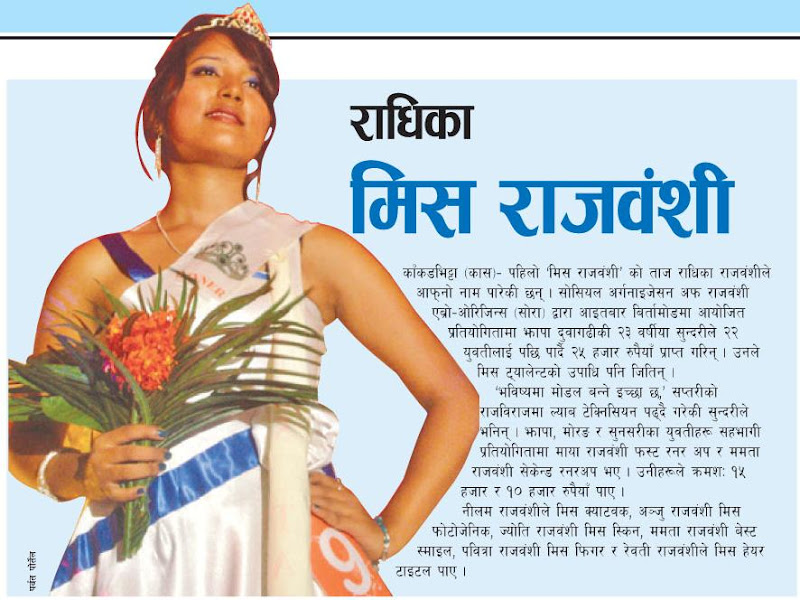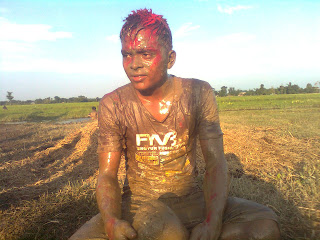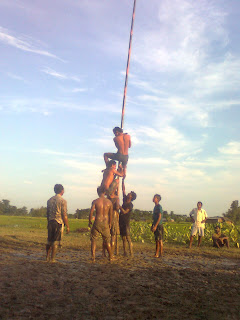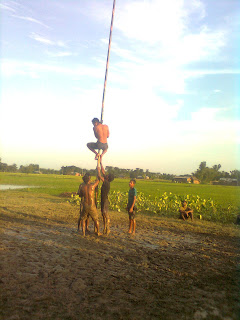 | |
| Tirsula Bir- a gaint in Rabaniya Nach of Rajbanshi Community |
 | |
| Actor of Rabaniya Nach Posed in Character of Rawan |
 | |
| Actors possed in Character of Ram and Sita in Rawaniya Nach ( Lanka Nach) of Rajbanshi Community |
Rawaniya Naach ( Lanka Naach)
This is a traditional drama played by peoples of Rajbanshi Community on the occasion of Ram Nawami but sometimes the Lanka Naach is being called to show in their village if they had promised God (as manti or vakal) to do so if their prayers are answered. All the actors of drama play the role of different characters of Ramayana- a holy epic of Hindus.
RABANIYA NACH also called Lanka Nach is a dramatic folk re-enactment of the life of Lord Ram, ending up in ten day battle between Lord Ram and Ravan, as described in the Hindu religious epic, the Ramayana.. A tradition that originates from the Indian subcontinent, the play is staged by Rajbanshi community Peoples during some occasion if their wishes are being fulfilled which they had promised to provide to God (Manti) and it is played often over ten or more successive nights, during the auspicious period of 'Sharad Navratras', which marks the commencement of the Autumn festive period.. Usually the performances are timed to culminate on the festival of Vijayadashami day, that commemorates the victory of Lord Ram over demon king Ravana, when the actors are taken out in a procession through the city, leading up to a mela ground or town square, where the enactment of the final battle takes place, before giant effigies of Ravana, his brother Kumbhakaran and son Meghanath are set fire, and coronation or abhisheka of Rama at Ayodhya takes place, marking the culmination of festivities and restoration of the divine order.
Rama is the 7th incarnation of Vishnu and central figure of the Ramayana. The Ramayana is based on the life, times and values of Lord Rama. Lord Rama is called the Maryada Purushottam or 'The best among the dignified'. The story of Lord Rama and his comrades is so popular in India that it has actually amalgamated the psyche of the Indian mainstream irrespective of their religion. The very story of Ramayana injects ethics to the Indian mainstream.
Most RABANIYA NACHs played are based on the 16th century Avadhi version of Ramayana, Ramcharitmanas, written by Gosvami Tulsidas entirely in verse, thus used as dialogues in most traditional versions, where open-air productions are staged by local RABANIYA NACHs committees, 'Samitis', and funded entirely by the local population, the audience. It is close to the similar form of folk theatre, Rasa lila, which depicts the life of Krishna, popular in Uttar Pradesh, especially Braja regions of Mathura, Vrindavan, and amongst followers of Gaudiya Vaishnavism and Vaishnavism in Manipur, with some similarity with Pandavlila of Garhwal, based on life of Pandavas of Mahabharat and Yakshagana of Karnataka, based on various epic and puranas
RABANIYA NACHs has received considerable global attention, especially due to its diverse representation throughout the globe, especially amongst regions where Hinduism has spread over the centuries, like Africa and several South East Asian countries. UNESCO proclaimed the tradition of RABANIYA NACHs a Masterpiece of the Oral and Intangible Heritage of Humanity in 2005.
HistoryHistorically
it is believed that first RABANIYA NACHs shows were staged by Megha Bhagat, one of the
disciples of Tulsidas,
the author of Ramacharitamanas in about 1625 AD, though there
are some evidence of its existence in some form before the creation of this
version as well. Some scholars believe its first appearance somewhere between
1200 and 1500 AD. Later during in the time of Mughal emperor Akbar, according to some,
Akbar is said to have watched a performance. Krishna Das Kaviraj mentions in his 16th century hagiography
of saint Chaitanya Mahaprabhu (1486–1533), Chaitanya Charitamrita, that once he got carried
away while performing the character of Hanuman at a play in Puri, thus proving
the existence of Ramayana plays, before the Ramcharitamanas appeared.[4]
Though it would safe to conclude that its implosion into the Hindi heartland,
happened only after Tulsidas created his version in people's language of the
time, the Avadhi,
unlike the original
written by Valmiki,
in Sanskrit,
the language only spoken by Brahmins by then, which excluded much of masses from
experiencing the inspirational saga, which is essentially the victory of good
over evil.












































































